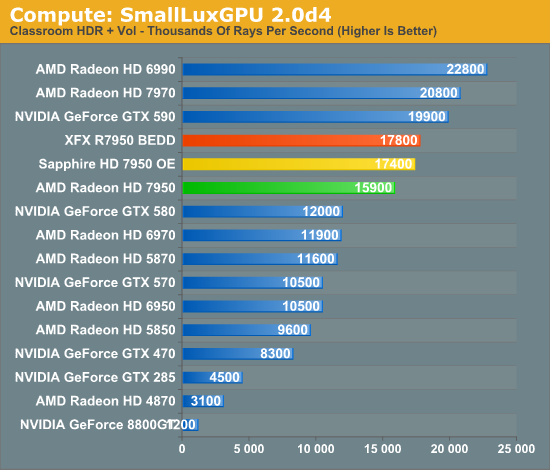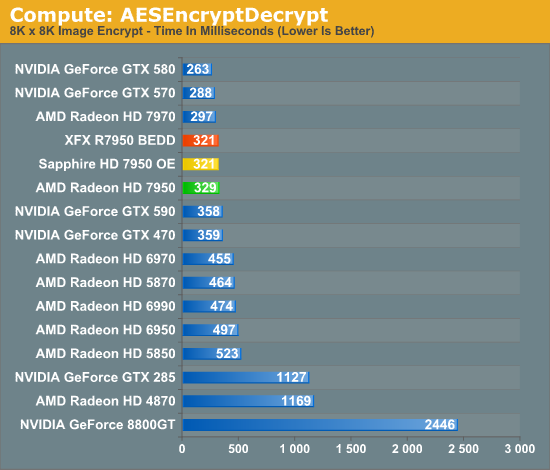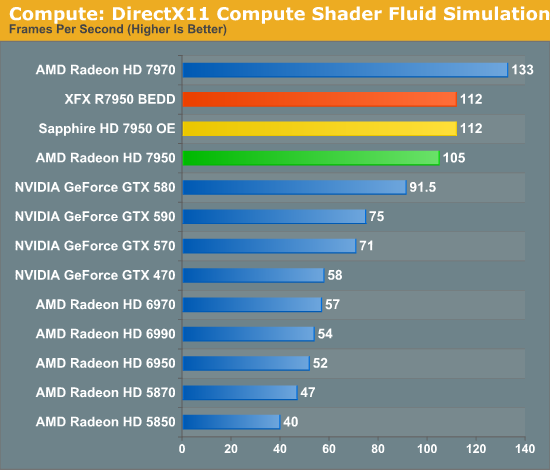AMD Radeon HD 7950 Review Feat. Sapphire & XFX: Sewing Up The High-End Market
by Ryan Smith on January 31, 2012 9:02 AM ESTCompute Performance
Moving on from our look at gaming performance, we have our customary look at compute performance. Since compute performance is by definition shader bound, the 7950 is at a bit of a disadvantage here compared to gaming performance. Whereas ROP performance scales with the core clock, shader performance is hit by both the reduction in the core clock and the disabled CU array.
Our first compute benchmark comes from Civilization V, which uses DirectCompute to decompress textures on the fly. Civ V includes a sub-benchmark that exclusively tests the speed of their texture decompression algorithm by repeatedly decompressing the textures required for one of the game’s leader scenes. Note that this is a DX11 DirectCompute benchmark.

AMD’s greatly improved compute performance continues to shine here, though in the case of Civilization V it’s largely consumed by just closing the previously large gap between the GTX 500 series and the Radeon HD 6000 series. As a result the 7950 falls ever so short of the GTX 580, while the factory overclocked Sapphire and XFX cards give the 7950 enough of a push to come within 5% of the 7970.
Our next benchmark is SmallLuxGPU, the GPU ray tracing branch of the open source LuxRender renderer. We’re now using a development build from the version 2.0 branch, and we’ve moved on to a more complex scene that hopefully will provide a greater challenge to our GPUs.

Under SmallLuxGPU the 7970 enjoyed a large lead over the GTX 580, and this continues with the 7950. Even though the 7950 is well behind the 7970—to the tune of 24%—it’s still 33% ahead of the GTX 580 and the lead only grows from there. Meanwhile the XFX and Sapphire cards can catch up to the 7970 somewhat, but as this is truly a shader-bound test, you can’t make up for the lack of shaders units on the 7950.
For our next benchmark we’re looking at AESEncryptDecrypt, an OpenCL AES encryption routine that AES encrypts/decrypts an 8K x 8K pixel square image file. The results of this benchmark are the average time to encrypt the image over a number of iterations of the AES cypher.

In spite of being a compute benchmark, AESEncryptDecrypt is not particularly sensitive to GPU performance, showcasing the impact that setup times can have. The 7950 trails the 7970 by 10%, and overclocking doesn’t change this much. Unfortunately for AMD NVIDIA is still the leader here, showing that AMD’s compute performance still has room to grow.
Finally, our last benchmark is once again looking at compute shader performance, this time through the Fluid simulation sample in the DirectX SDK. This program simulates the motion and interactions of a 16k particle fluid using a compute shader, with a choice of several different algorithms. In this case we’re using an (O)n^2 nearest neighbor method that is optimized by using shared memory to cache data.

With the compute shader fluid simulation we once again shift back into a compute task that’s much more shader-bound. The 7950 only reaches 80% of the performance of the 7970, once more proving the real impact of losing a CU array. This is still enough to handily surpass the GTX 580 however, with the 7950 taking a 15% lead.










259 Comments
View All Comments
Finally - Monday, February 6, 2012 - link
"While the performance is impressive, the pricing is just ridiculous and leaves a bittter taste in the mouth."That's why you don't put your GPUs in the mouth and chew on them...
kallogan - Tuesday, January 31, 2012 - link
Lamest pricing policy ever. AMD has apparently decided to stop selling gpus. Fine.Love the undervolted/Oced Sapphire. Undervolting is my way of life.
mdlam - Tuesday, January 31, 2012 - link
Why do you post this nonsense on a 7900 discussion? Does anyone who owns a top tier video card give a rats behind about undervolting? No. That's why you spend 30 dollars and buy a hd6770.kallogan - Tuesday, January 31, 2012 - link
You must have been hurt in some ways by my comment cause you're being agressive kitty.Look at the power consumption and noise levels. The sapphire despite a 100mhz OC blows every other card.
You can't say it's useless.
Ryan1981 - Tuesday, January 31, 2012 - link
The website of sapphire is listing a stock clocked version of the 7950:http://www.sapphiretech.com/presentation/product/?...
Just thought I'd include it.
Ryan1981 - Tuesday, January 31, 2012 - link
Ok after closer examination, almost stock, 810 Mhz Core clock.poohbear - Tuesday, January 31, 2012 - link
can you please use resolutions that the avg user uses? whats thsi 1980x1200 nonsense? who games at that resolution? by far the most popular resolutions are 1650x1050 & 1920 x1080. why not just post figures for those instead of having us guessing?UMADBRO - Tuesday, January 31, 2012 - link
HERP!1920x1080 is 16:9, 1920x1200 is 16:10.
DERP!
Black Obsidian - Tuesday, January 31, 2012 - link
Not to mention that if you game at 1680x1050, you don't need a high-end card anyway, and so have no reason to care how they benchmark at your Cro-magnon resolution. If you get a real monitor (1920x1200 or higher), you can come back for the performance numbers already provided in the article.piroroadkill - Tuesday, January 31, 2012 - link
My machines basically all use 16:10 screens. I have two laptops with 15" 1920x1200 screens, my main monitor is a U2410.. 1920x1200..